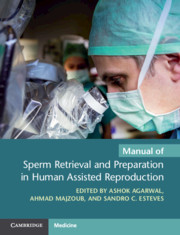Book contents
- Manual of Sperm Retrieval and Preparation in Human Assisted Reproduction
- Cambridge Laboratory Manuals in Assisted Reproductive Technology
- Manual of Sperm Retrieval and Preparation in Human Assisted Reproduction
- Copyright page
- Dedication
- Contents
- Contributors
- Editor Biographies
- Preface
- Part I Introduction
- Chapter 1 Anatomy and Physiology of the Male Reproductive System
- Chapter 2 Evaluation of Candidates for Sperm Retrieval
- Chapter 3 Testicular Histopathology and the Role of Testis Biopsy
- Part II Sperm Retrieval
- Part III Laboratory Handling of Retrieved Sperm
- Index
- References
Chapter 1 - Anatomy and Physiology of the Male Reproductive System
from Part I - Introduction
Published online by Cambridge University Press: 09 April 2021
- Manual of Sperm Retrieval and Preparation in Human Assisted Reproduction
- Cambridge Laboratory Manuals in Assisted Reproductive Technology
- Manual of Sperm Retrieval and Preparation in Human Assisted Reproduction
- Copyright page
- Dedication
- Contents
- Contributors
- Editor Biographies
- Preface
- Part I Introduction
- Chapter 1 Anatomy and Physiology of the Male Reproductive System
- Chapter 2 Evaluation of Candidates for Sperm Retrieval
- Chapter 3 Testicular Histopathology and the Role of Testis Biopsy
- Part II Sperm Retrieval
- Part III Laboratory Handling of Retrieved Sperm
- Index
- References
Summary
The male reproductive system is a complex network of central nervous system circuits and internal and external pelvic organs. The hypothalamic–pituitary–gonadal (HPG) axis leads to reproductive tract formation and development during embryogenesis, sexual maturation at puberty, and testosterone and sperm production by the testis as an adult. Spermatogenesis is regulated by pulsatile secretions of GnRH, LH, and FSH and feedback regulation on the HPG axis. Immotile spermatozoa are produced within the seminiferous tubules of the testis. During transport through the epididymis, sperm undergo the maturation processes to induce motility and subsequent fertility. Sperm are transported through the ejaculatory ducts and into the urethra during ejaculation, combining with the seminal fluid that provides a nutrient-rich environment, assists in sperm motility, and suppresses the immune response in the female reproductive tract.
Keywords
- Type
- Chapter
- Information
- Publisher: Cambridge University PressPrint publication year: 2021

